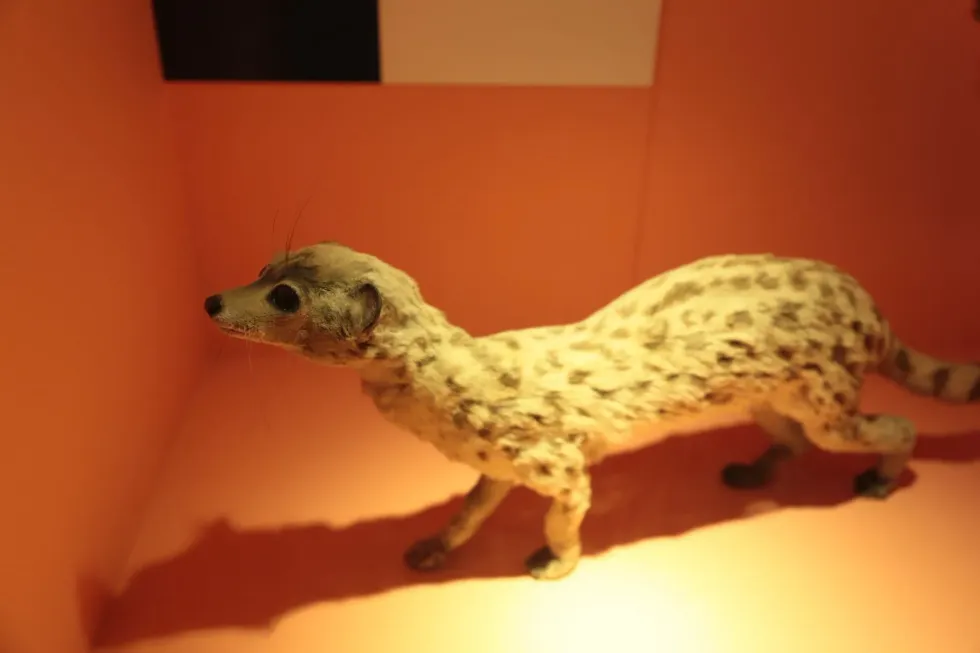The African linsang lives in the region of western Africa. Also known as the Oyan, this mammal can be seen spending most of its time on trees in the wild. This is because they are arboreal.
They have a long slim body almost resembling a cat! However their elongated head and pointy muzzle are prominent enough for people to realise that they are wild animals! The African linsang has a yellow-brown fur coat, with dark oval spots over its body, the underside of their body is creamy white.
Their tails too are pretty long and dark in color. The spots on the Oyan stretch into stripes, making them look exotic!
These cute mammals have triangle ears and a long tail. Did you know that their forelegs are shorter than their hind legs? This is a rare characteristic that the African linsang possesses.
If you like reading about animals, give our clouded leopard and paint horse facts a try!
African Linsang Interesting Facts
What type of animal is an African linsang?
The African linsang like other linsang mammals comes from the Civet family. They are long and slim animals that love spending time on trees in the wild.
It is nocturnal meaning that it is mainly active at night. They are hardly every seen on ground. This species is known for its fur and meat which is why it is subjected to being hunted by humans.
What class of animal does an African leopard belong to?
The Oyan are nocturnal animals from the family Viverridae (civet) found in western and central Africa. They belong to the class of mammalia.
Their scientific name is Poiana richardsonii and they are often mistaken with its other subspecies such as the Asiatic linsang or the spotted linsang. They are carnivores and often feed on insects, cola nuts, small birds as well as plan based foods.
How many African linsangs are there in the world?
Although these arboreal animals face a couple of threats their population as of now is not known. Regardless of being hunted by humans for their meat and fur, they are not endangered and fall into the category of Least Concerned species. They may also be hunted by owls and snakes as well as other large carnivores.
Where does an African linsang live?
The African linsang (poiana richardsonii) lives in forests of central and western Africa. They are defined by their arboreal personality and therefore are seen in areas with lots of trees. They are not seen much on land.
Even their nests are a few feet above ground level. One thing to note about the nocturnal linsang is that they don't stay in the same nest for a long time, they are constantly moving to newer nests. They can also be found on Bioko island.
What is an African linsang's habitat?
The Poiana richardsonii are often seen in habitats with dense forests and jungles. Rainforest areas as well as wetlands are a common place to find these elongated linsang!
Their nests are built around six feet from ground level. They are also seen in high range altitudes of 984- 3116 ft (300-950 m). These linsangs are pretty quick on their feet.
Who do African linsangs live with?
African linsangs (poiana richardsonii) either spend their lives with a mate or in solitary. Often the young linsangs lives with the mother. It has been observed that multiple linsangs house one nest. This species often has only one partner for all its life.
How long does an African linsang live?
The lifespan of the African linsang poiana richardsonii is about five years. Their lifespan is far less compared to other species such as the spotted linsang (prionodon pardicolor) and the banded linsang (prionodon linsang) that live up to nine to ten years.
How do they reproduce?
There is not much information available regarding their breeding habits. They are known to breed using their olfactory cues.
Since the African linsang poiana richardsonii is a mammal, it is assumed that the mother provides nourishment to the young linsang. Young linsangs stay within their nests until they are old enough to look for food with their mother. The range of their litter size is between two to three.
What is their conservation status?
The exact number of population of the linsang is unknown. However unlike the spotted linsang (prionodon pardicolor) that are endangered, these species have an abundant population. Although this species is subjected to being hunted for fur and meat, it has not affected them on a large range.
African Linsang Fun Facts
What do African linsangs look like?
These cute animals are a sub species of the banded linsang (prionodon linsang) and the spotted linsang (prionodon pardicolor). However unlike their Asian relatives, the spots around their shoulder stretch into bands. They have slender bodies that are medium sized with a long tail.
They have exceptional eyesight. This species has a yellow-brown body with dark oval spots. Often see hanging out on trees, they stay off ground!

*Please note that this image is of a banded linsang, not of an African linsang. If you have an image of a African linsang, please let us know at hello@kidadl.com
How cute are they?
They are quite cute, one would almost think it is a cat at first sight, but with a more detailed view, they'd realize this is a wild animal. They are small, but their slender and their elongated body enhance their length to the viewer.
This species is known for its long tail and dense fur. In their natural habitat, one might see young linsang nuzzling with the mother.
How do they communicate?
They use olfactory cues to communicate with each other. They don't use vocal sounds, unlike other mammals. They are seen nuzzling their bodies with their mates and their offspring. They are solitary in nature and therefore this species is not the most vocal or social in nature. While breeding, it has been observed that they use their olfactory senses.
How big is an African linsang?
This species have slender bodies. The African linsang size depends on its diet. They are not very big however they do have an elongated body. Its tail is just as long. They can grow up to 12-16 in (33-43 cm) in length. They are ten times smaller than a cheetah!
How fast can an African linsang run?
There isn't much relevant information regarding how fast it can run. The African linsang habitat mostly consists of trees and they are almost never seen on ground.
How much does an African linsang weigh?
They weigh between 17.62 -24.67 oz (500-900 g). Given their length, they are relatively small in size.
What are the male and female names of the species?
There are no specific names assigned to the male and female species.
What would you call a baby African linsang?
Often animals offspring from the civet family are called "toddycats". However there is no specific name assigned to this species.
What do they eat?
Unlike the spotted linsang (prionodon linsang) and the banded linsang (prionodon pardicolor), this species also eats plant based foods like nuts, seeds, fruits and leaves. Their carnivore diet often consists of small birds, insects.
Are they poisonous?
No, these wild animals are shy and scared of humans. They stick to themselves. They are not harmful towards humans.
Would they make a good pet?
This species is not known to be kept as a domestic pet, so it is highly unlikely.
Are African linsangs endangered?
No, this species is not endangered. Their population is stable and labelled as Least concern.
Why is it also called a central African oyan?
The linsang has many names, its also called as a central African Oyan due to its habitat distribution amongst central africa unlike its other relatives that are from the Asian regions.
Here at Kidadl, we have carefully created lots of interesting family-friendly animal facts for everyone to discover! For more relatable content, check out these tiger facts and lion facts pages.
You can even occupy yourself at home by coloring in one of our free printable African linsang coloring pages.










